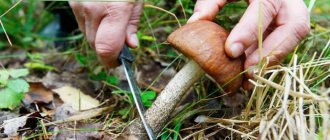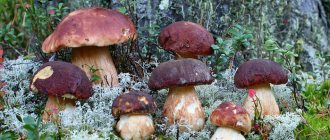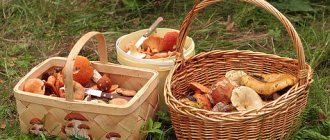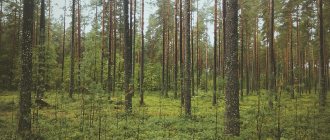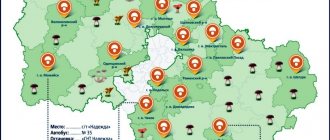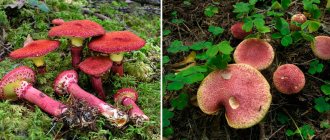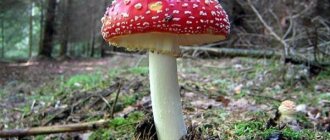Where to pick mushrooms and berries?
Perhaps, let's start with the most important thing - a place where it is safe to search for mushrooms and berries.
You've probably heard about the toxicity of mushrooms and their extremely unpleasant property of absorbing harmful substances. Because of this, even an edible mushroom can be dangerous to humans.
To minimize this risk, carefully choose the place where you are going to “hunt”. Choose forests located away from mass settlements, industrial production and major highways.
Collect mushrooms in forests located far from industries and major highways
Better yet, come to Lyubogorye! It’s not for nothing that we are considered an eco-resort: our club is located in a forest area, hidden from the road by a tall array of coniferous trees. Few Russian resorts can boast such a convenient location.
Our forests are rich in healthy mushrooms and berries, and there is no doubt about their environmental friendliness! By the way, you can take the mushrooms home, cook them in the kitchen, or give them to our chefs, who will make a delicious dish for you.
When does the mushroom season start in 2022?
For mushrooms to start growing, several conditions are necessary. First of all, it is a warm land. In the vicinity of the capital, if the weather is appropriate, the first mushrooms may appear on the soil surface in the spring. At this time of year, the earth is saturated with moisture and warm enough. In April and May, mushroom pickers encounter morels, less often boletus mushrooms, and in early June boletus and porcini mushrooms.
After the first June rains, the next stage of growth begins. In summer, the periods of mushroom appearance are very short, they can last only 1 week. In dry summers, they may not appear at all. Experienced mushroom pickers believe that the main period of growth of forest products begins closer to September and continues until October, and in warm autumn - until November.
What are the benefits of mushrooms and berries for the body?
Picking mushrooms and berries is an exciting leisure activity that is doubly enjoyable, because your “catch” is also very good for your health! Let's figure out what benefits you will bring to your body and what harm you risk causing.
Medicinal properties of mushrooms
Let's start with the fact that it is simply delicious! And eating mushrooms in the fall also helps strengthen the immune system and resist seasonal viruses.
Some are even treated with mushrooms. This is called fungotherapy - one of the types of traditional medicine, which is based on the preservation of the full complex of active substances contained in mushrooms. For this purpose, decoctions, infusions and extracts are made from them.
Mushrooms are used in cooking, folk and traditional medicine
But even in traditional medicine, mushrooms play an important role - they are actively used in pharmaceuticals. Even for antibiotics we should be grateful to fungi: penicillin and streptomycin are obtained from mold fungi!
Let's move on to specifics and start with the king of the mushroom kingdom - the porcini mushroom (aka boletus). Porcini mushrooms contain a record amount of healthy proteins: a kilogram of porcini mushrooms contains more proteins than a kilogram of beef.
Another beneficial property of porcini mushrooms is the presence of nicotinic acid (vitamin PP), which is necessary for heart health! Boletus mushrooms also contain iron salts, zinc, iodine, copper and vitamin B1.
Milk milk is practically the only source of vitamin D of non-animal origin. We usually get this vitamin from dairy products, cod liver and sun exposure. In addition, milk mushrooms do an excellent job of preventing kidney and pulmonary diseases.
You will get a large dose of vitamins A, B1, B2, zinc and selenium from chanterelles. These mushrooms are beneficial for the spleen and general immunity of the body. Their benefits have also been proven for diabetes.
Chanterelles are useful for diabetes and in restoring the pancreas
And even in restoring the pancreas, chanterelles are the first helpers (although in case of serious diseases of this organ, nutritionists advise not to get carried away with mushrooms)! They are also the only mushrooms that do not accumulate radioactive substances.
Other mushrooms of the Novgorod region are also rich in useful substances and vitamins; the main thing is to pay attention to the collection and their further preparation.
Poisonous wild berries
Before you go picking berries, you need to study not only the edible types, but also those whose consumption can pose a threat to human life and health.
May lily of the valley
Herbaceous perennial plant reaching 30 cm in height. White flowers appear from May to June, followed by orange-red fruits up to 8 mm in diameter. This occurs from June to July. Despite the beauty of the berries, they are incredibly toxic.
May lily of the valley is a perennial plant that is very poisonous and can cause serious poisoning.
Maiden grape five-leaf
A large vine with shoots up to 3-4 meters, densely packed with 5-lobed leaves. In early July it is covered with white flowers, collected in umbels of 3-5 pieces. These then produce bunches of grapes that are blue-black when ripe.
Five-leaved maiden vine is a deciduous vine with inedible fruits
Nightshade bittersweet
Also known as privet berry or viper grass. It is a subshrub with thin stems and red oblong berries. Eating the fruits of this plant causes severe rashes and irritation, and if an allergic reaction occurs, it can be fatal.
Bittersweet nightshade is a toxic plant that can cause poisoning
Nightshade black
Other names are crowberry or witch berry. This is a herbaceous plant with black shiny berries formed in clusters. Both unripe and ripe berries can cause harm to health.
Black nightshade is an evergreen shrub whose berries contain a poisonous alkaloid, solanidine.
Belladonna
Also known as belladonna or mad cherry. This is a herbaceous plant with shiny, flattened yellow or blue-black berries. It has a long stem up to 90 cm in length and large leaves. The berries are very poisonous, especially for children: dry mouth, rapid heartbeat, dilated pupils, followed by loss of consciousness, fever, blue mucous membranes and death.
Belladonna is a perennial, very poisonous plant.
Kupena fragrant
Other names are kokornik, Solomon's seal or wolf berries. This is a perennial herbaceous plant that grows up to 50 cm. It has an erect stem with elliptical leaves. From May to June, white fragrant flowers produce blue-black berries with a bloom of up to 12 mm. They are also extremely poisonous.
Kupena fragrant is a herbaceous poisonous perennial with high medicinal properties.
Buckthorn brittle
Sometimes called a korushatnik or medvizhnaya. This shrub up to 4.5 m in height is found throughout the country on fertile soil in the shade of tall trees. Poisonous blue-black spherical fruits with a diameter of up to 10 mm.
Buckthorn is a berry plant whose fruits have a laxative effect.
Forest honeysuckle
Tatar or Caucasian honeysuckle should be distinguished from the few types of edible honeysuckle. They are typically red, black or orange in color and round in shape.
Forest honeysuckle is a shrub that grows in coniferous and mixed forests
Wolf's Bast
Other names are wolfberry or badman. It is a shrub with bright red berries that emerge from small flowers similar to lilacs. The fruits are extremely dangerous for humans; you should not even touch them.
Wolf's bast is a plant famous for its poisonous properties.
Red-fruited crow
This is a herbaceous plant with clusters of large red or black oval berries. When consumed, they cause nausea, vomiting, hallucinations and convulsions.
Red-fruited crowberry is a perennial plant with toxic berries.
Snowberry white
The plant grows on rocky, calcareous soils in partial shade. They have poisonous large white berries.
White snowberry - a poisonous shrub with beautiful white fruits
Spotted arum
Also known as calf's foot, aron, or snake grass. It is a perennial herbaceous plant with hemispherical leaves and bright red berries. Very poisonous, when consumed it causes disturbances in the gastrointestinal tract, arrhythmia, convulsions and hallucinations.
Spotted arum is a perennial plant with variegated leaves.
Phytolacca americana
Another name is red ink plant. It is a herbaceous perennial with a branched stem up to 4 m high. The leaves are oval and large, small white flowers are collected in a tassel-shaped inflorescence. From them dark purple berries up to 8 mm in diameter then appear.
Phytolacca americana is a berry perennial with poisonous fruits.
Phytolacca fruits are poisonous; even contact with the juice can cause an allergic reaction.
Euonymus
It is an evergreen shrub with smooth leaves. It blooms with pale greenish or brownish small flowers, collected in inflorescences of 4-5 pieces. Afterwards, poisonous berries appear from them - reddish dry pear-shaped boxes.
Euonymus is a picturesque evergreen plant with small flowers.
Voronets spica
Also known as stink grass or Christophorus grass. It is a herbaceous perennial that grows up to 60 cm in height. It has an erect, branched stem and jagged, ovate-shaped leaves. Small flowers form inflorescences in May or June.
In July or August, succulent black leaflets appear. They are inedible, and after consumption all the signs of food poisoning appear.
Voronets spica - a plant that has an unpleasant odor and high toxicity
Elderberry herbal
It is a perennial herbaceous plant up to 150 cm in height. It has an erect thick stem and compound leaves consisting of 9-11 leaflets with serrated edges. It blooms with white, pink or red paniculate inflorescences from May to July.
Elderberry is a perennial shrub with white, red or bluish-black clusters.
The shiny, spherical fruits look like black drupes, about 4 mm in length. They appear from August to September.
Swamp whitewing
Also known as swamp calla. This plant has thick glossy leaves, bright flowers and beautiful red berries. It is toxic; if the juice of the berries gets on the skin, severe irritation occurs.
Swamp whitewing is a poisonous plant that grows in wetlands.
Lakonos or Phytolacca americana
An herbaceous perennial growing up to 3 m, with several smooth reddish-green stems and ovate, pointed leaves. The white flowers are very small; they appear in June-August and are located at the ends of the shoots and form inflorescences.
Lakonos, or American phytolacca, is a large perennial plant with powerful shoots.
Signs of poisoning by this plant are vomiting, convulsions, headache, speech impairment, paralysis and death.
Yew berry
Also known as greenwood, greenwood, or mahogany. It is a very beautiful tree with reddish-brown bark and shoots. In April, green flowers form, from which pink or yellow berries appear in the fall. However, all parts of the tree, with the exception of the seedlings, contain poison.
Yew berry is notable for its beauty, durability and toxicity.
Common privet
Another name is wolfberry. It is a tree or shrub up to 5 m high with round black fruits. The berries contain the substance solanine, which has a strong toxic effect on the human body.
Common privet is a poisonous plant due to its solanine content.
Crow's eye
Other names include cuckoo tears and bear berry. These are large, round black berries that are very similar to blueberries. The fruits of the crow's eye are located one at a time at the ends of the shoots. Another distinctive feature is the presence of wide oval leaves, usually 4 or 5 pieces.
Crow's eye is a short plant with berries similar to blueberries or blueberries.
Not only the berries, but also other parts of this plant are poisonous to humans.
Useful properties of berries
No less important and beneficial for the body are berries, which the Novgorod region is so rich in! They contain a lot of vitamins, microelements, fiber and antioxidants.
It’s not for nothing that our grandmothers considered berry jam and tea to be the first remedy for colds. Berries strengthen the immune system, help treat arthritis, normalize blood pressure, and prevent age-related dementia.
The positive influence of berries on the human psyche has also been proven. Thanks to folic acid, which promotes the production of serotonin, even a small handful of berries can make you feel happy. In the age of depression, this will be a real salvation!
Berries help in losing weight, fighting depression, treating arthritis and strengthening the immune system.
By the way, those who are struggling to maintain a slim figure should include berries in their diet. This will speed up your metabolism, which will help you lose weight.
The leaders in beneficial properties are the following berries:
- Blackberries – lowers blood cholesterol levels;
- Blueberries – improves vision;
- Cranberry – strengthens the immune system.
But raspberries, strawberries, and gooseberries also contain many vitamins and microelements beneficial to the body.
That is, I can collect a jar of birch sap?
Yes you can. But there are also rules here if you plan to collect juice for sale. According to the order of the Ministry of Natural Resources, this can be done in areas of mature forest no earlier than five years before felling. Tapping (making a cut on a tree trunk during its growing season) in plantations where selective felling is carried out is allowed to be done on trees that are scheduled for felling.
You can collect sap from birch trees whose diameter at chest height is 20 cm or more. The channel is drilled at a height of 20-35 cm from the root collar of the tree (the place where the roots pass into the stem). The larger the diameter of the tree, the more channels can be drilled to collect sap.
After you have finished collecting the sap from the tree, you need to coat the cut channels with gum paste or close them with a wooden plug and cover them with varnish, garden putty or clay with lime. This is necessary to prevent birch diseases.
More detailed rules may also be established at the local level. But they must not contradict federal law.
Gold reserve freezer. We prepare healthy dishes from berry reserves Read more
Harm from mushrooms and berries
Although doctors advise using both mushrooms and berries in your diet more often, you shouldn’t rely heavily on them either, otherwise it can have negative consequences for the body.
We will not talk about poisonous mushrooms; their danger to humans is already obvious. But edible species can also be harmful. Firstly, as already mentioned, the ability to accumulate harmful substances is the weak point of mushrooms. Therefore, there is a risk of running into a poisoned, although outwardly quite harmless mushroom.
Even edible mushrooms can become poisonous if grown in the wrong place
We once again insist that the place where you go to pick mushrooms and berries must be environmentally friendly, because you cannot distinguish a normal mushroom from an infected one!
But you should also be careful with an environmentally friendly product. Frequent consumption of mushrooms can lead to serious gastrointestinal diseases. We “owe” this to the protein chitin, which is difficult for humans to digest. There is also a risk of poisoning when a stale, wormy mushroom ends up in your basket.
As for berries, there are poisonous species among them, so you need to be careful when picking. Pick only familiar fruits. In addition, there is a risk for those who are overly fond of this product: from an allergic reaction to problems with tooth enamel.
Excessive consumption of berries will have a bad effect on tooth enamel.
By the way, you should not pick berries growing next to toadstools. Fungal spores can be carried by the wind onto the fruit and cause harm to the body.
Mushroom picking table + photo
- Morels
in May - until the 15th; in June, July and August - absent.
Searches should be carried out in young aspens where there is sufficient daylight and humidity levels.
- Butter
in May - from 14 to 31; in June - from 1 to 15, until the heat begins; in July and August, growth can be increased only in case of precipitation.
- Chanterelles
May - absent; from mid-June to the end of August - in large quantities, suitable for cooking and freezing for the winter.
You can collect chanterelles in any forest. However, as the practice of most mushroom pickers shows, most often and in large volumes, fruits germinate in mixed forests.
- Porcini
Boletuses grow actively from mid-June until the first frost, which falls for most regions in November - December. The fruits are collected from old forests as soon as the semi-white varieties are gone.
- Obabki
Boletuses and boletuses have an identical fruiting schedule. The only difference between them is that the place of growth comes from the name.
in June - the first half of the month; in July and August - all 8 weeks.
- Mosswort
As in the case of porcini mushrooms, fly mushrooms begin active growth in June, completing the annual harvest only at the end of autumn. Finding them is not difficult. However, in order not to make a mistake and harm your health, you should first familiarize yourself with the distinctive characteristics.
- Honey mushrooms
Compared to other types of mushrooms, honey mushrooms have many subspecies. The calendar for 2022 speaks of large fruiting beginning in mid-spring. Growth stops only during frosts, when temperatures are below zero. Depending on the region of residence, lovers of quiet hunting can hunt for the spring, summer, autumn and even winter subspecies - flammulina.
- Saffron milk caps
Coniferous mushrooms, which prefer sawdust, germinate most often from mid-summer - July. Peak season falls in August and September. The final ten days are October and December.
- Milk mushrooms and volnushki
Despite the fact that some mushrooms are considered noble, while others are considered conditionally edible, fruiting occurs in early August. The exact deadline may vary one to two weeks earlier or, conversely, later than the due date.
Edible and inedible mushrooms: learning to distinguish
Surely you will recognize the fly agaric without our help. But problems can arise with other mushrooms. The greatest difficulties will arise with the identification of the pale toadstool, which can be mistaken for russula or forest champignon, the satanic mushroom, which is so similar to porcini or oak, and a whole series of false mushrooms that “copy” chanterelles, honey mushrooms and boletus.
Fortunately, inedible mushrooms, while generally similar in appearance to edible ones, have characteristic features that should alert the mushroom picker.
To distinguish the pale toadstool from the russula, you need to look at the stem...
Let's start with the pale toadstool. Carefully examine the stem of the mushroom for rings. There are no such rings on green russulas; this is a typical “decoration” of the toadstool. At the bottom, the stalk of the poisonous mushroom also has a volva - a membranous wrapper - and tuberous thickenings at the base. These mushrooms seem to grow from a “pot”. By the way, this “pot” can also reveal other poisonous mushrooms.
To avoid confusing a toadstool with a champignon, look under the cap of the mushroom. In a young edible mushroom the plates are pink, with age they become brown, but in the toadstool they are always white.
...And the difference with champignons is visible in the cap
But here you need to be very careful, because even a slight distortion in the lighting can play a cruel joke on you. Experienced mushroom pickers advise beginners to give up champignons altogether and focus on collecting other mushrooms so as not to make a fatal mistake.
To eliminate the satanic mushroom, it is worth breaking off a piece from the cap. In the porcini mushroom, the place of the break will retain its original color, in the oak mushroom it will immediately turn blue, but in the satanic one it will first turn red and only then turn blue. This should be done right there in the forest, without waiting to return home.
Satanic mushroom is identified by its changing color and unpleasant odor.
In addition, the pulp of the poisonous mushroom usually gives off an unpleasant odor, reminiscent of rotten onions. True, young satanic mushrooms do not spread miasma.
Let's move on to false mushrooms. Poisonous counterparts have a common feature - they are usually brighter than their edible originals. But the differences don't stop there. False honey mushrooms, for example, unlike natural ones, do not have a skirt that connects the cap to the stem.
Natural chanterelles have corrugated cap edges, while false ones have smooth edges. And the caps and legs of real butterfish are slippery and shiny, which is especially noticeable in wet weather. The cap of the mushroom seems to be covered with oil, which is how the mushrooms got their name. In wet weather the cap is glossy. And it always has a spongy structure, whereas the cap of false butterflies is often lamellar.
False mushrooms have a brighter color and differ in the structure of the cap
Mushroom growth calendar by month
Most regions of Russia, Ukraine and Belarus allow mushroom picking all year round, with the exception of a few months. Positive air temperatures exceeding 0 degrees will allow mushroom pickers to collect maximum usefulness in the form of flammulina. Winter honey fungus on trees, stumps and at their feet is visible from afar. The reddish hue stands out brightly from December to February, as if begging to be included in the collecting baskets. However, germination can be higher than a person's height, so when going on a quiet hunt, it is recommended to take a ski pole with you.
Fruiting periods, list by month:
- in January - mushrooms can be detected in exceptional cases if the air temperature remains abnormally warm. Germination is possible in the following families: oyster mushrooms, porcini mushrooms, winter mushrooms and truffles in small quantities;
- in February - you can see only two species: oyster mushrooms and winter mushrooms. Even in the southern regions, early fruiting in the last month of winter is impossible;
- in March - the germination of oyster mushrooms and honey mushrooms continues. However, if frost persists in the region, going in search of a mushroom delicacy is not advisable;
- in April, as years earlier, from the middle of the month, active fruiting of morels and strings begins. The latter can be poisonous, so it is recommended to carefully study the distinctive features and methods of heat treatment in order to remove poisons, toxins and carcinogens;
- in May, as in the first month of spring, morels and strings are actively growing until the daytime temperature exceeds 20 degrees Celsius, and the rains are replaced by drought. From the middle of the month, mushroom pickers can begin a quiet hunt for mushrooms (aspen and boletus), russula;
- in June - boletus mushrooms appear first, boletuses and boletus mushrooms continue to grow. In many regions with forested areas famous for coniferous trees, they often find: russula, champignons and chanterelles;
- in July, in addition to the mushrooms listed in June, the calendar recommends checking for the presence of meadow and summer mushrooms, milk mushrooms and umbrellas from the champignon family. After rain, even in abandoned areas, puffballs and moss mushrooms actively sprout;
- in August - germination of summer mushrooms continues. However, in addition to the above list, the list is replenished with: saffron milk caps and boletus, Assumption honey mushrooms, in rare cases, rows;
- in September, go to the forest, look for noble breeds of mushrooms. In deciduous and coniferous zones, depending on the place of fruiting, you can find: porcini and Polish mushrooms, obabka, champignons and chanterelles, saffron milk caps and oyster mushrooms. If the harvest does not live up to expectations, alternatives will be: russula and rows, autumn honey mushrooms (including thick-legged mushrooms);
- in October, the situation is identical. The subspecies of mushrooms known to everyone are almost identical. However, old pines remain an ideal place for mycelium of hygrophores and spruce mushrooms;
- in November, the mushroom season begins to wane, reducing the number of quiet hunters to a minimum. Only the most courageous mushroom pickers, who know a lot about preparing first and second courses, salads and snacks for strong drinks, can appreciate the presence of the following species in the forest thicket: truffles, honey mushrooms and oyster mushrooms;
- in December, germination persists only in warm regions with a mild climate. In the vast forests at temperatures above zero, mushroom pickers can go for flammulina, truffles and oyster mushrooms.
What to wear and take with you?
The first rule is comfort. You will have to bend over often and walk a lot, so clothes should be loose, made of thick fabric, shoes should be comfortable, rubber boots with an elastic band on the top are best.
Things should be comfortable and loose, because you will have to walk and bend over a lot
Don't forget your hat! An old baseball cap, a Panama hat, a hat - anything will do as long as it protects you from ticks and mosquitoes.
Be sure to take water, sandwiches, a raincoat, a bandage and iodine, an antihistamine, and mosquito and midge repellent with you. You can pack warm clothes in case the weather gets worse, as well as a compass and whistles (helpful if anyone gets off course).
And don’t forget about the container in which you will collect your “catch”. Wicker baskets are best suited for this. Buckets, plastic containers or bags are not suitable: firstly, the mushrooms may break, the berries may become wrinkled, and secondly, your harvest will quickly deteriorate if it does not have enough air.
In a wicker basket, the collected mushrooms or berries will not be wrinkled and will receive enough air for better preservation
What does a mushroom forest look like?
- If we talk about an ideal forest, where you can pick up everything that mushroom pickers consider noble mushrooms - porcini, aspen, boletus, chanterelles, boletus and so on - then you need to look for places where cattle have been grazing for many years. Cows and other livestock are big chewing machines for fertilizing fields. Imagine that they fertilized the soil like this for several decades, and then these pastures turned out to be abandoned and began to be overgrown with young mixed forest. 10-20-year-old fir trees, birches, pines stand on a former pasture, and all this is sunny, with normal ventilation, with good moisture... This is a real mushroom Klondike! And we have such forests: full of abandoned state farms, whose fields are overgrown. That's where we need to go. In fact, such a place is a giant edge, and we know that the edge, the border of forest and field, is the most mushroom place in any forest. They generally like to grow on the borders of different formations.
An ideal forest is one where you can collect all the noble mushrooms. Photo: pixabay.com
In general, the forests in the Moscow region are the sickest and most unkempt. Accordingly, this is the kingdom of autumn honey fungus.
How to pick mushrooms correctly?
Many mushroom pickers still believe that the mushroom must be cut with a knife, but under no circumstances should it be picked. It is believed that otherwise the mycelium can be damaged, and then next year the “mushroom garden” will not grow here.
Mushrooms can be cut with a knife or picked by hand
This is the oldest misconception, sown by elementary ignorance of biology. The underground part of the mushroom is reliably protected; to damage it will require considerable effort from you.
True, when pulling it out, it is easy for an inexperienced mushroom picker to damage the stem, which will lead to rapid rotting of the mushroom. But this won't happen if you are careful. So whether to tear or cut is a matter solely of your convenience and habit.
A rare species of mushroom was found in the Moscow region
It is reported that mushrooms listed in the Red Book were discovered for the first time in the Dmitrievsky district of the Moscow region. This was stated by representatives of the press service of the Ministry of Ecology. Experts managed to find a rare plant - sarcosome globulus. About 300 mushrooms were found in a small area; fortunately, they were all in perfect condition. This information was conveyed to representatives of the Red Book.
Over the past few months, this is the second discovery of similar mushrooms in areas where they have never been seen before. Previously, a colony of mushrooms was discovered in the Rues urban district. This rare species of mushroom is known to have medicinal properties. This mushroom cannot be eaten, but in some cases it can actually be used to heal a wound. However, local residents are asked not to collect or eat them.
Subject:
- mushrooms
